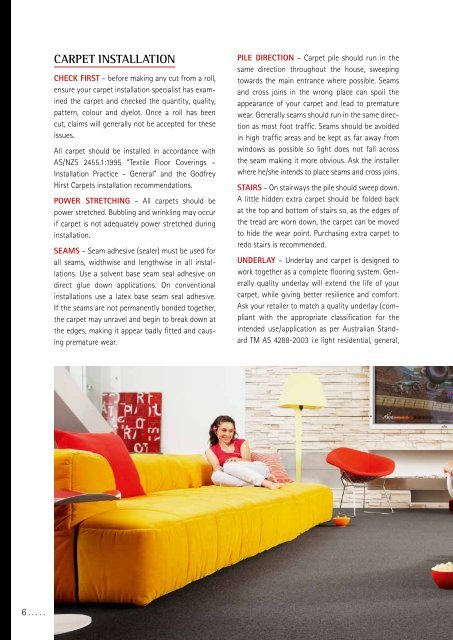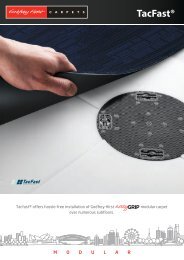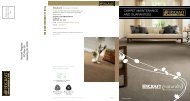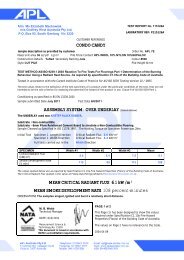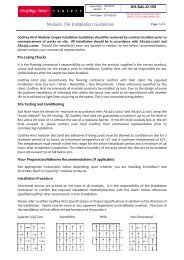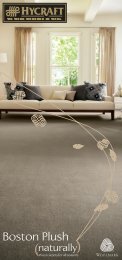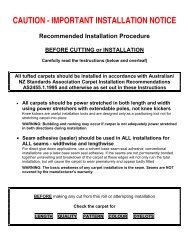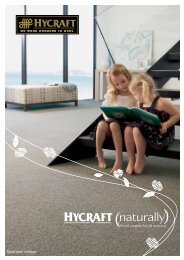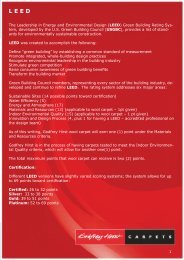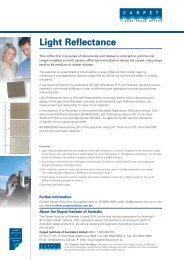carpet Guide - Godfrey Hirst Carpets
carpet Guide - Godfrey Hirst Carpets
carpet Guide - Godfrey Hirst Carpets
Create successful ePaper yourself
Turn your PDF publications into a flip-book with our unique Google optimized e-Paper software.
Carpet Installation<br />
Check First – before making any cut from a roll,<br />
ensure your <strong>carpet</strong> installation specialist has examined<br />
the <strong>carpet</strong> and checked the quantity, quality,<br />
pattern, colour and dyelot. Once a roll has been<br />
cut, claims will generally not be accepted for these<br />
issues.<br />
All <strong>carpet</strong> should be installed in accordance with<br />
AS/NZS 2455.1:1995 “Textile Floor Coverings –<br />
Installation Practice – General” and the <strong>Godfrey</strong><br />
<strong>Hirst</strong> <strong>Carpets</strong> installation recommendations.<br />
Power Stretching – All <strong>carpet</strong>s should be<br />
power stretched. Bubbling and wrinkling may occur<br />
if <strong>carpet</strong> is not adequately power stretched during<br />
installation.<br />
Seams – Seam adhesive (sealer) must be used for<br />
all seams, widthwise and lengthwise in all installations.<br />
Use a solvent base seam seal adhesive on<br />
direct glue down applications. On conventional<br />
installations use a latex base seam seal adhesive.<br />
If the seams are not permanently bonded together,<br />
the <strong>carpet</strong> may unravel and begin to break down at<br />
the edges, making it appear badly fitted and causing<br />
premature wear.<br />
Pile Direction – Carpet pile should run in the<br />
same direction throughout the house, sweeping<br />
towards the main entrance where possible. Seams<br />
and cross joins in the wrong place can spoil the<br />
appearance of your <strong>carpet</strong> and lead to premature<br />
wear. Generally seams should run in the same direction<br />
as most foot traffic. Seams should be avoided<br />
in high traffic areas and be kept as far away from<br />
windows as possible so light does not fall across<br />
the seam making it more obvious. Ask the installer<br />
where he/she intends to place seams and cross joins.<br />
Stairs – On stairways the pile should sweep down.<br />
A little hidden extra <strong>carpet</strong> should be folded back<br />
at the top and bottom of stairs so, as the edges of<br />
the tread are worn down, the <strong>carpet</strong> can be moved<br />
to hide the wear point. Purchasing extra <strong>carpet</strong> to<br />
redo stairs is recommended.<br />
Underlay – Underlay and <strong>carpet</strong> is designed to<br />
work together as a complete flooring system. Generally<br />
quality underlay will extend the life of your<br />
<strong>carpet</strong>, while giving better resilience and comfort.<br />
Ask your retailer to match a quality underlay (compliant<br />
with the appropriate classification for the<br />
intended use/application as per Australian Standard<br />
TM AS 4288-2003 i.e light residential, general,<br />
6 . . . . .


